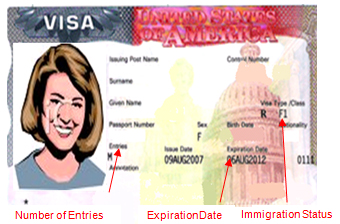Your visa stamp is what allows you to enter the US. The kind of visa you have indicates what your purpose is in the US. In this case, your F-1 visa shows that your purpose in the US is to be a student. When you enter the US, your I-94 Entry/Exit record will assign you an immigration status based on your visa type – in this case, F-1 status.
The visa stamp includes your personal information, where the visa was acquired, what kind of visa it is, when it expires, and how many times you can use it.
Most students will receive “M” under the “Entries” section, which means “Multiple” entries. In other words, as long as the visa dates are valid you can use it as many times as you like. Occasionally students will receive 1 or 2 entries per visa, though this is rare.
F-1 Visa Expiration and Renewal
Your visa stamp allows you to enter the US, so once it is expired you can no longer return to the US with that visa. However, it is NOT a problem if the visa expires while you are in the US. The visa’s purpose is to allow you to enter the US – once you are here, your I-20 and I-94 are what determine your immigration status. This is similar to going to a concert or movie – your ticket is very important to enter, but after you enter the building, you don’t really need the ticket anymore. Your visa is kind of like a ticket to enter the US.
There is no limit to the length of time you can be in the US with an expired visa, as long as your I-20 and I-94 are valid.
If your visa has expired, you will need to renew it after you leave the US next, but before you return to the US. There is no way to renew your visa in the US – this can only be done at a US Embassy outside of the US. This does not necessarily have to be at the Embassy nearest your home. Many Embassies welcome “third country nationals,” which are individuals that are not citizens of the country they are applying for a visa to enter, and are also not citizens of the country they are applying for the US visa in. Some UMBC students will take a trip to Canada, for example, to renew their visa. Please note you should be aware of entry requirements to any country other than your own – you may need a visa to enter that country as well.
Why do different students have different amounts of time on their F-1 student visa?
The length of a visa is determined by the “reciprocity rule.” This means that the US and your country agree on a mutual amount of time that citizens of each country can get different kinds of visas. You can see a table of the maximum length of time available for each visa category for citizens of different countries here.
While typically students in the F-1 visa category are given the maximum amount of time, regardless of long their I-20 is, this is not always the case. The nature of the student visa category is that your plans can change – after completing one degree, you might go on to work on OPT, or you might start a new degree at another school, for example. Thus, most of the time applicants for a student visa in the US will get the full amount of time available for someone from their country, even for a visa renewal. However, the consular officer conducting the interview has the ultimate decision and may occasionally choose to only make your visa for the length of time on your I-20 or another, shorter amount of time, though it is not clear what the factors for this decision might be. In general, students will receive the maximum amount of time possible for someone from their country on an F-1 visa.